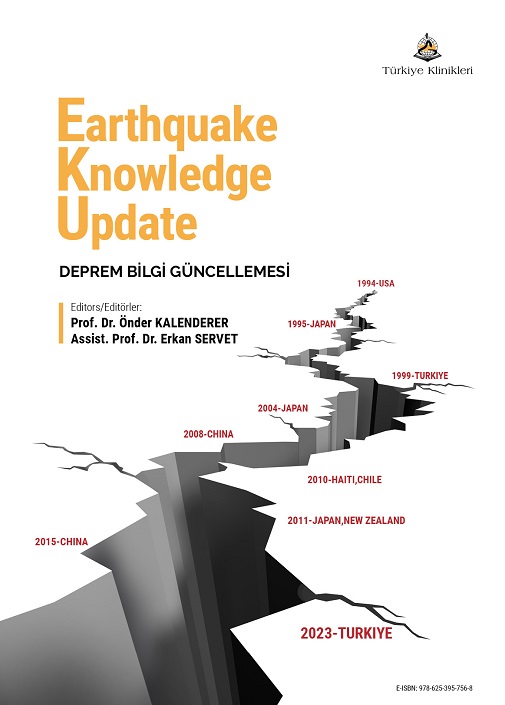“It is necessary to consider preventive and protective measures before disaster strikes; once it has occurred, lamenting serves no
purpose.”
Mustafa Kemal ATATÜRK
When an earthquake or a similar natural disaster occurs, all systems established for normal life collapse within minutes. While the struggle for survival begins for the earthquake victim, for those who are both victims and healthcare professionals, survival is accompanied by the challenge of keeping others alive as well; those difficult minutes are followed by hours, days, and even weeks. These are the times when everyone exerts superhuman effort, filled with moments where critical decisions must be made within minutes to save human lives. For us as physicians in particular, these are often periods when, in order to save a patient, we are forced to sacrifice the patient’s limbs or other organs, times when we enter an incredible battle between science and conscience, burdened with memories, or rather nightmares, that we can never forget throughout our lives. These are times that leave us forever torn between the questions: “Could it have been done better?” and “If only I had tried, at least I could have saved the life.” In pursuit of answers to these questions in the light of science, we set out with 46 of our esteemed colleagues working in different hospitals across 15 different cities. As a result of a long-term effort, we have brought forth this book by drawing upon the knowledge and experience of our distinguished colleagues who have lived through the bitter reality of earthquakes and have conducted studies on disasters such as earthquakes. With the wish that it may shed light and provide guidance to all our physicians in the face of future earthquakes that may confront both our country and the world.
Prof. Dr. Önder KALENDERER
İzmir Tınaztepe University, Faculty of Health Sciences,
Department of Orthopedics and Traumatology,
İzmir, Türkiye
Assist. Prof. Dr. Erkan SERVET
Gaziantep University, Faculty of Medicine,
Department of Orthopedics and Traumatology,
Gaziantep, Türkiye
Bölümler
01 | Earthquakes in the World and Türkiye (Why Are They So Important?)
Tülin TÜRKÖZÜ, Önder KALENDERER
02 | Preliminary Preparation (Equipment, Disaster Team, Coordination)
Mahmut KURTBOĞAN, Yasin Emre KAYA
03 | First Aid and Triage
Buğra KUNDAKÇI, Melih BAĞIR
04 | Surgical Preparation and Timing
Hüseyin Utku ÖZDEŞ, Emre ERGEN
05 | Crush Syndrome
Ayşe BALAT, Mehmet Şükrü SEVER
06 | Patient Management in Intensive Care Unit
Ayşegül AKSOY, Ayşe MIZRAK
07 | Head and Neck Injuries in Earthquakes
Ali NEHİR, İsmail AYTAÇ
08 | Thorax Injury
İbrahim Emre TUNCA, Ahmet ULUŞAN
09 | Abdominal Injuries
Latif YILMAZ, Ersin BORAZAN
10 | Peripheral Nerve Injuries in the Extremities Resulting From Earthquakes
Nevzat GÖNDER, Burçin KARSLI
11 | Soft Tissue Defects and Flaps
Namık Kemal KILINCCIOĞLU, Aydıner KALACI
12 | Compartment Syndrome and Fasciotomy Techniques
Çağrı KARABULUT, Savaş GÜNER
13 | Amputation Decision
Duran TOPAK, Ökkeş BİLAL
14 | Fracture Management: Open-Closed Fracture
Mert GÜNDOĞDU, Volkan KILINÇOĞLU
15 | Spinal Fractures
Yiğit AKSOĞAN, Orhan BÜYÜKBEBECİ
16 | Pelvis and Acetabulum Fractures
Alp Yekta GÖKALP, Sezgin Bahadır TEKİN
17 | Upper Extremity Fractures
Erkan SERVET, Sami SÖKÜCÜ
18 | Lower Extremity Fractures
Bahri BOZGEYİK, Günhan KARAKURUM
19 | Follow Up and Orthesis-Prosthesis Practice
Serap İNCEBIYIK SATIŞ, Özlem ALTINDAĞ
20 | Orthopedic Complications of Earthquake and Their Treatments
Şeyhmus YİĞİT, Emin ÖZKUL
21 | Psychological Effects at Patients and Medical Staff
Muhammet SANCAKTAR, Bahadır DEMİR
22 | How to be Prepared for the Next Earthquake Coordination Between Hospitals and Cities, Selecting The Support Hospitals and Planning the Teams
Umut ÖKTEM, Emre KARADENİZ
23 | Strengthening Orthopedic Disaster Preparedness in Türkiye: The Role and Strategic Vision of TODAK After the 2023 Earthquakes
Durmuş Ali ÖÇGÜDER, Mehmet DEMİRHAN



